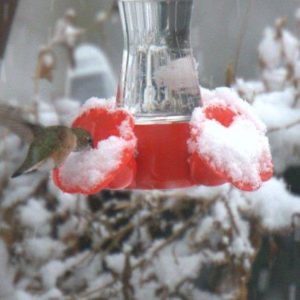-
Regardless of what the groundhog says…hummingbird feeders!
What’s wrong with this picture? It hasn’t been photo-shopped or altered, and it’s certainly a real hummingbird. Oddly enough, these tropical migratory birds have been known to overwinter on several occasions. Nobody really knows why they would even want to stay and brave such harsh weather, especially when all their buddies head south… a mere 3 to 5 thousand miles! This nectar can’t be all that special?
On Cape Cod, there was even a big news story last year, where one lonely Ruby Throated was made famous! A few residents were hanging heat lights over their hummingbird feeders to keep nectar from freezing! Another reported bird made headlines in North Carolina too.
Regardless of what Punxsutawney Phil decides, hummingbird feeders should be out, filled and ready before the birds actually make their way to your neck of the woods. Project Ruby Throat and some other sites even track the great migration, with reports of the first birds arriving from the south and their directional sprawl north, east and west.
Since hummingbirds are so darn territorial, it might be a good idea to start thinking about adding an additional feeder this year, especially if you’d like to see more of the buzzing antics in your yard. If you hosted them last year… the same ones will likely return! And if you’ve never made your own nectar… this is definitely the season to start! We think the birds prefer the home made solution over commercial mixes any day. NO red dye needed. The recipe is so simple, it’s table sugar (cane sugar only) and water… that’s it! Check out some suggested plantings (along with the recipe) that will help lure the birds as well.
And make a vow to keep feeders fresh this year, hummingbirds may not return to a feeder that has spoiled nectar. Every two to three days nectar should be changed in the height of summer and extreme temps. You may not want to fill the feeder all the way unless most of the nectar is being used in between cleaning and filling.
Here’s hoping for an early spring!
-
Received a hummingbird feeder for Christmas? Two words: ant moat
The tiny sprites are mesmerizing, you could sit and watch their antics for hours if time allowed! Definitely one of the most endeared birds, hummingbirds are in a class of their own. A magical experience to have them around your place during the season.
What’s not so magical is the fact that ants love sugar water too. (Yes, nectar is simply sugar water you can easily make yourself- recipe link at the end). Without fail, pesky ants will find a way to invade the sweet, sticky nectar, and when they do, hummingbirds won’t drink the solution. So you end up with wasted nectar and a bunch of ants, some dead, some still alive. They’re dead because they can’t swim… silly ants!
That’s why ant moats are so perfect with these feeders. Placed above the hummingbird feeder, the ant moat holds water, and ants can’t cross the water successfully. The ant moat usually has a double-end hook, so the feeder hangs directly from it. The top hook on the ant moat is basically the main hanger. It’s a one-time investment, and very reasonable considering the results. You’ll save nectar, save money, and your hummingbirds will be happy too!
Oh yeah… and the really simple nectar recipe can be found here.
-
tiny ports on hummingbird feeders… an easy clean
Whether traditional tube style, or basin style, all hummingbird feeders have one thing in common…very tiny feeding ports! These tiny ports tend to build up a “black mold” during summer’s extreme temperatures. Rinsing hummingbird feeders with hot water does not always remove this gunk. Sugar water gets very nasty, even fermenting within just a few days. Hummingbirds will rarely re-visit a feeder that has bad nectar.
To keep your little sprites happy and keep them around for the season, squeaky clean hummingbird feeders and fresh nectar are essential. So just how do you clean those itty-bitty feeding ports? The secret weapon is an old mascara brush! Before tossing your next (or grab your wife’s) mascara, save the brush and run it through the dishwasher to remove all the makeup and residue. These make the perfect cleaning brush for feeder ports on any tube style hummingbird feeders, and basin styles as well.
By the way, if you’re still buying commercial nectar… it’s time to try and make your own. The recipe is so very simple and it takes less than five minutes. Our hummingbirds prefer the plain sugar water, and once we started feeding it, there was a dramatic increase in visitors who stuck around the entire season.
So here’s the recipe to the stuff to fill your hummingbird feeders with: one cup plain table sugar to four cups water. That’s it! Nothing else in the mixture as it will harm or kill hummingbirds. No need to boil the water either, microorganisms are spread through the bird’s bills… not the feeders or nectar. We do boil one cup of water, simply to dissolve the sugar quicker and more effectively. You can then store unused nectar in the fridge for up to two weeks.
So this season, save the mascara brush and try your own nectar!





